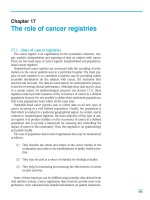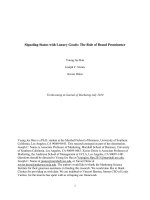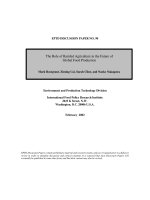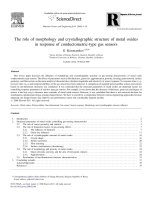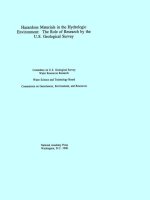Meeting Environmental Challenges: The Role of Human Identity docx
Bạn đang xem bản rút gọn của tài liệu. Xem và tải ngay bản đầy đủ của tài liệu tại đây (660.68 KB, 93 trang )
Meeting Environmental Challenges:
The Role of Human Identity
Tom Crompton and Tim Kasser
Meeting Environmental Challenges:
The Role of Human Identity
Tom Crompton and Tim Kasser
First published in 2009
by WWF-UK
Panda House, Godalming,
Surrey, GU7 1XR
www.wwf.org.uk
© WWF-UK
Distributed by Green Books Ltd.
Foxhole, Dartington, Totnes,
Devon TQ9 6EB
www.greenbooks.co.uk
Permission is granted to reproduce material in this
volume without prior written consent so long as proper
attribution is made.
ISBN 978-1-900322-64-5
WWF’s Strategies for Change Project
This publication is one of a series produced as part of WWF-UK’s Strategies for
Change Project. This project seeks to examine the empirical basis for today’s
dominant approaches to environmental communications and campaigns, and to
ask why these are failing to create the level of change that is needed. Electronic
versions of this book, and other related publications, can be freely downloaded
at: www.wwf.org.uk/strategiesforchange.
Join the debate!
We hope that this short book will stimulate wide and critical debate – not
just amongst the environmental movement, but amongst the third sector
more generally. To help support this debate, we have set up a website, www.
identitycampaigning.org, which we will use for developing these ideas further,
testing them, and inviting critical comment.
Crisis can bring opportunity. It challenges the institutions that guide our deci-
sion-making and it can profoundly affect our individual sense of identity. The
growing worldwide awareness and experience of economic, social, and envi-
ronmental crises seem to be prompting a renewed condence among people to
ask fundamental questions: Where are self-enhancing and materialistic values
leading us? How important is our relationship to people on the other side of the
world and to other species? What needs to change if we are to cope with the
overwhelming scale of the problems humanity faces?
We cannot know with any certainty where such questioning will lead us. But this
publication, Meeting Environmental Challenges: The Role of Human Identity,
helps clarify how the environment movement and the third sector as a whole can
begin to respond to these challenges. The authors have amassed a sophisticated
theoretical and empirical case for a fundamental re-evaluation of mainstream
approaches to environmental communications and campaigning. Their thinking
goes beyond an analysis of the problems of our current approach: it also suggests
clear and intriguing new possibilities that hold a great deal of promise.
Agree with it or challenge it – but either way, prepare for change.
David Norman
Director of Campaigns
WWF-UK
INTRODUCTION
PART I:
HUMAN IDENTITY AND
ENVIRONMENTAL CHALLENGES
Chapter 1 Values and life goals
Chapter 2 In-groups and out-groups
Chapter 3 Coping with fear and threats
PART II:
IDENTITY CAMPAIGNING:
STRATEGIES FOR ADDRESSING THE
ENVIRONMENTALLY PROBLEMATIC ASPECTS
OF HUMAN IDENTITY
Chapter 4 Shifting values and life goals
Chapter 5 Reducing prejudice towards non-human nature
Chapter 6 Promoting healthier coping with fear and threats
Summary of Part II
PART III:
REASONS TO BE CHEERFUL:
NEW OPPORTUNITIES OFFERED BY
IDENTITY CAMPAIGNING
Chapter 7 Four good things about identity campaigning
Chapter 8 Beyond the environment: opportunities for new coalitions
ENDNOTES
REFERENCES
About the authors and acknowledgements
1
7
8
11
15
23
26
37
46
55
57
58
64
69
73
81
The epochal scale of today’s environmental challenges is now beyond serious
scientic dispute. Awareness of the scale of these challenges grows ever greater
– in the case of climate change, it seems that the prognoses of climatologists
grow yet more urgent on an almost weekly basis. And as this awareness grows,
so too does our understanding of the gulf between what needs to be done and
what is actually being done.
The environmental movement has achieved a great deal in attempting to
meet these environmental challenges, investing remarkable effort with limited
funding against powerful countervailing forces. In these attempts, the environ-
mental movement pursues two basic types of strategy: engaging organisations
(both government and businesses) and engaging the particular behaviours that
individual citizens pursue. Here we present an overview of these two strategies
as a prelude to introducing a third approach to which we feel the environmental
movement must pay close attention. We believe that this third approach, which
we call identity campaigning, holds substantial promise for enhancing the ef-
fectiveness of the movement’s current work and for developing useful strategies
for new types of intervention.
Engaging organisations
Much of the environmental movement’s current focus is on engaging organisa-
tions. For example, one dominant approach relies upon the development and
renement of policy proposals, coupled with political lobbying to encourage
the adoption of these proposals by government. This is an important strategy;
there is no doubt that the environmental movement has been pivotal in the
development of many key environmental policy proposals, and in successful
political campaigns to see these adopted by government. Consider, for example,
the development of new efciency standards, restrictions on pollution, or the
establishment of protected areas.
But, as most environment campaigners would probably agree, current
policy responses fall far short of the level of intervention needed, and this ap-
proach is frequently vulnerable to the critique, levelled by Shellenberger and
Nordhaus in their paper The Death of Environmentalism, that “[t]he environ-
mental movement’s technical policy orientation has created a kind of myopia:
everyone is looking for short-term policy pay-off” (Shellenberger and Nord-
haus, 2003: 25).
Interrelated constraints imposed by a lack of political leadership and a
lack of electoral demand – along with opposition from strong vested interests
– often frustrate attempts to create policy interventions, so that these do not de-
liver the extent of regulatory change needed to address systemic environmental
problems.
In failing to respond properly to today’s environmental challenges, gov-
ernments are guilty of capitulating their leadership responsibility – and the lack
of public pressure for ambitious new government interventions cannot excuse
this failure. Nonetheless, in the face of this regrettable government timidity, it
is crucial that environmental organisations nd more effective ways to generate
and mobilise public pressure for change. How will irresistible electoral demand
for sufcient regulatory intervention and global leadership emerge? Today’s
environmental movement doesn’t seem to have a clear response to this ques-
tion.
Responding to the problem that business interests often present for pol-
icy reform, a second, more conciliatory approach to organisational engagement
seeks to demonstrate a convergence between commercial interest and environ-
mental imperative – the ‘business case for sustainable development’. There is no
doubt that where this convergence can be found (for example in improvements
in the efciency of the use of raw materials or energy in a production process),
environmental impact can be reduced at the same time that money can be saved
(or made). The prospect of better leveraging this coincidence of commercial
and environmental interests has led to the frequent insistence by government
that environmental challenges be met through ‘de-coupling’ economic growth
and environmental impact. Such approaches place emphasis, for example, upon
opportunities to dismantle market distortions (including subsidies, or tariffs on
trade in environmental goods and services) that both exacerbate environmental
problems and depart from today’s neo-liberal economic orthodoxy. Clearly,
making such cases can be environmentally benecial, and is often politically
expedient.
Important as these interventions are, emphasis upon the economic pru-
dence of some environmental measures risks fuelling a reluctance to confront
other policy interventions that may not lie so comfortably with the grain of cur-
rent economic orthodoxy. Such cases arise frequently. Environmental regula-
tion is often opposed on the grounds that it will conict with economic growth,
2
INTRODUCTION
3
and such claims sometimes bear scrutiny – particularly where a short-term
perspective is taken, or high discounting rates are assumed. More often still,
ambitious regulatory interventions may never even be publicly discussed be-
cause of the chilling
1
effect of insistence that environmental regulation must be
compatible with economic growth, the prots of businesses, or the sovereignty
of consumer choice.
In sum, a focus on engagement with organisations – whether govern-
ment or private sector – can point to clear successes in driving through new
environmental policies and regulations, and changes in business practice. But
such interventions are proving woefully inadequate. If they are to be made pro-
portionate to the scale of challenge we face, this will likely be as a result of both
new and bold government and business leadership, and of public pressure.
Engaging behaviour
The second dominant approach, of engaging specic behaviours, is typied by
presenting individual citizens with checklists of ‘things you can do to reduce
your ecological footprint’. By focusing on behaviours, the political difculties
inherent in engaging organisations are avoided and emphasis is shifted away
from government and business onto the individual. Increasingly, approaches
to motivating behaviour change retreat from using information campaigns
coupled with moral exhortations; this is certainly understandable, given the
limitations of such strategies. Instead, approaches to motivating the uptake of
particular behaviours typically draw on marketing techniques. The emphasis of
such campaigns is upon motivating large numbers of people to adopt specic
behaviours – often to make ‘simple and painless’ choices. These techniques
offer obvious opportunities to collaborate with manufacturers and retailers to
urge new forms of ‘green consumerism’, and are thus complementary to the
organisational strategies described above. Such approaches to engaging behav-
iour usually remain indifferent about the deeper values or goals that motivate
people to adopt these behaviours; campaigns might, for example, appeal to the
nancial savings that accrue from switching to low-energy light bulbs or tting
double glazing, or the status that comes with purchasing a hybrid car or a bottle
of organically grown wine. Focus is maintained on the behaviour, rather than
the people engaging in the behaviour. To the extent that the people and their
motivations are considered, this is with a view to better tailoring communica-
INTRODUCTION
tions to urge a change in behaviour – it is not with a view to examining and
shifting underlying values or goals.
2
Certainly this approach makes perfect tactical sense in creating piece-
meal behaviour change, and it no doubt works well for marketing agencies
contracted to sell as many units of a particular product as possible. Behaviour
also has the advantage of being easily examined and analysed – an action is
performed, or it is not. But campaigns focused primarily on simple and pain-
less behaviour changes may well work against the emergence of a set of goals
and motivations that will lead to more systemic adoption of pro-environmental
behavioural choices. What’s more, experimental evidence does not support
the common assumption that, having adopted one specic pro-environmental
behaviour, people are then necessarily more likely to engage in other more dif-
cult and signicant pro-environmental behaviours (WWF, 2009).
Identity campaigning
Both of the dominant approaches outlined above – focussing on organisations
and on behaviours – can point to important successes. But it is also clear that
neither has generated the political space and irresistible pressure necessary for
adequate regulatory intervention, the fundamental reform of business practice,
or the far-reaching changes in individual lifestyle choices that will be needed
in order to meet today’s environmental challenges.
Given the enormity of these challenges and the inadequacy of current
strategies to meet them, we have attempted in this short book to delineate a third
type of approach to environmental campaigning that the environmental move-
ment has thus far seemed largely to neglect. We call this identity campaigning,
as it focuses on those aspects of a person’s identity that either lead them to
demand more ambitious change on the part of organisations, or that underlie
their motivation to engage in pro-environmental behaviour. Our proposal is
that acquiring an understanding of the psychological make-up of the person
who participates in organisations and who makes private-sphere behavioural
choices, will help both of the dominant approaches to be more effective. Fur-
ther, identity campaigning will help environmental organisations to foresee and
avoid some of the ways in which current strategies may have counter-productive
effects. Finally, understanding the psychological make-up of the person opens
up a number of additional types of interventions that can be used in efforts to
address environmental problems.
4
INTRODUCTION
To this end, we suggest that there are certain aspects of the human
psyche that create proclivities towards unsustainable behaviour. In this book,
we focus on three specic aspects of human identity. We will argue that these
proclivities are often reinforced, or enabled, by social norms and structures,
by the government policies that shape these, and even sometimes by the ac-
tions of environmental organisations themselves. It seems to us that today’s
environmentalism by and large either retreats from confronting these aspects
of identity, choosing to ignore them, or alternatively attempts to ‘work with’
them, trying to co-opt them to serve environmental purposes. Unfortunately, as
we shall see, co-opting them risks making these environmentally problematic
aspects of identity even more prevalent.
It is important to emphasise that we are not suggesting there is any-
thing abnormal about these aspects of identity – quite the opposite. These are
ubiquitous facets of the human psyche. They may be just as basic to the psyche
of those who strive to minimise their environmental impact as they are in those
who are indifferent to such impact. But their ubiquity does not mean that these
facets of human nature are necessarily dominant, or that other, competing and
more positive aspects of identity cannot be brought to the fore.
It is inevitable that our society, however structured, will serve to make
some aspects of human identity more prevalent than others. It is also clear that
governments play a key role in this process. Policy makers may be “uncom-
fortable with the idea that they have a role in inuencing people’s values and
aspirations. But the truth is that governments intervene constantly in the social
context” (Jackson, 2009: 94). Our interest is in the ways that social context
serves to accentuate those aspects of identity which, according to the research we
present, tend to undermine approaches to meeting environmental challenges.
It seems to us that the mainstream environmental movement has rarely
invested resources into examining these environmentally problematic aspects
of human identity, identifying the social structures that enable and accentuate
them, and working to change these structures so as to encourage more environ-
mentally benecial aspects of human identity. And yet, until an understanding
of the person is integrated with current environmental strategies, and until the
environmental movement begins to tackle these aspects of identity and the
social norms and structures that enable them, we fear that responses to the
environmental crisis will remain inadequate.
5
INTRODUCTION
The rst step in this process, of course, is to examine more publicly how
certain aspects of human identity are associated with environmental problems;
Part I of this book begins this process. The second step is to identify strategies
to mitigate the extent to which these aspects of human identity are encouraged,
and to promote alternative aspects that are not so damaging; Part II of this
book undertakes that examination and proposes a number of new approaches,
strategies, and perspectives on environmental campaigning. Finally, in Part
III we highlight some of the opportunities that this approach to environmental
campaigning offers, and the grounds for optimism that it can be of crucial impor-
tance in supplementing, modifying, or replacing current campaign strategies.
In particular, we develop a case for extending identity campaigning to address
concerns and challenges beyond environmentalism, and point to the opportuni-
ties for new and concerted approaches to joint campaigning across a diverse
range of third-sector organisations.
6
INTRODUCTION
PART I:
HUMAN IDENTITY AND
ENVIRONMENTAL CHALLENGES
In Part I we identify three aspects of human identity that empirical research
suggests are associated with behavioural decisions that often serve to frustrate
optimal responses to environmental challenges. Identity refers to people’s sense
of themselves: who they think of themselves as being. Most identity theorists
agree that identity inuences how people respond to the broader social world
and how they choose to live their lives, and that this sense of self emerges from
the conuence of internal psychological dynamics on the one hand and the
social context on the other.
Clearly there is substantial room for subjectivity in deciding which
aspects of the human psyche in general, and of human identity in particular,
are especially important in determining humans’ responses to environmental
challenges. Our choice of the processes described below is based on three main
factors. First, of course, is our own particular knowledge of psychology. Second,
as alluded to above, is the existence of theoretical and empirical work demon-
strating that these aspects of human identity are associated with unsustainable
responses to environmental challenges. Third, as will be seen in Part II, is the
existence of evidence suggesting that these aspects of identity might be ame-
nable to a variety of interventions.
We make no claim that the three aspects of identity we have selected
constitute a complete list, or that we have even succeeded in identifying the most
important features of the human psyche involved in frustrating the emergence of
proportional responses to environmental problems. Rather, our hope is that this
analysis will stimulate those in the environmental movement to further examine
the ways in which their communications and campaigns inuence aspects of
identity, so that existing strategies for promoting sustainability will be made
more effective, and so that new strategies can be developed.
Chapter 1
Values and life goals
Values and life goals are the aspects of people’s identities that reect what
they deem to be desirable, important, and worthy of striving for in their lives
(Rokeach, 1973; Schwartz, 1992)
3
. As with other aspects of identity, values and
goals have both internal determinants, based on psychological needs and drives,
and external determinants, based on the social models and experiences people
encounter (Schwartz, 1992; Kasser, 2002). Substantial empirical and theoretical
work demonstrates that values and life goals have important ramications for
people’s attitudes and behaviours (Feather, 1992). This is because values and
life goals are understood to be higher-order cognitions that inuence the more
specic attitudes individuals hold with regard to the people, objects and ideas
they encounter in the world. For example, compared to someone who cares little
about security, a person who believes security is important is likely to be more
attracted to home security systems, and to be more supportive of governmental
policies that ensure low crime rates – even if these come at the cost of some
civil liberties. Values and life goals are also understood to reect higher-order
motivations that organise the more specic goals and low-level behaviours
that constitute many aspects of people’s day-to-day lives (Emmons, 1989). So,
for example, security values are likely to inuence whether a person holds the
handrail while descending steps or which of several different investment op-
portunities he or she will pursue.
Substantial cross-cultural research has identied around a dozen values
and goals that consistently emerge across nations. What’s more, as we shall see
later, the organisation of these life goals and values is remarkably consistent
across cultures.
Among these is a set of values and goals focused on wealth, rewards,
achievement and status. For example, Shalom Schwartz and colleagues (1992,
2006) have identied the existence of two types of self-enhancing values that
consistently emerge across 70 nations as fundamental and coherent aspects of
people’s value systems. Schwartz calls these values ‘power’, or the desire to
dominate people and resources, and ‘achievement’, or the desire to demonstrate
one’s success relative to others.
4
Other work by Grouzet and colleagues (2005)
across fteen nations has documented the cross-cultural emergence of a similar
set of life goals, labelled extrinsic or materialistic. These goals, which are fo-
9
cused on the attainment of external rewards and social praise, include specic
aspirations for nancial success, popularity and having a socially desirable
image.
Quantitative empirical studies document that people who strongly en-
dorse such self-enhancing, materialistic values also express more negative at-
titudes towards non-human nature. For example, Wesley Schultz and colleagues
(2005) studied almost 1,000 university students from six nations and found that
values for power and achievement were associated with viewing humans as
consumers of, rather than part of, nature. Schultz and colleagues also reported
that stronger values placed on power and achievement are associated with less
concern about how environmental damage affects other humans, children, fu-
ture generations and non-human life. Where these self-enhancing values pro-
mote concern about ecological damage, this concern is limited to an egotistic
consideration of how such damage might affect one personally. Similar results
in Australia (Saunders and Munro, 2000) and the US (Good, 2007) have been
documented for measures related to materialistic goals: caring more about such
goals is associated with signicantly less positive attitudes towards the environ-
ment, and with lower levels of biophilia (the desire to afliate with life).
Values have been found to inuence behaviour as well as attitudes.
Studies in the US and the UK show that adolescents who more strongly endorse
materialistic goals in life report themselves as being less likely to turn off lights
in unused rooms, to recycle, to reuse paper and to engage in other positive
environmental behaviours (Gatersleben et al., 2008; Kasser, 2005). Similar
ndings have been reported for American adults, amongst whom materialistic
values are found to be negatively correlated with the frequency of engagement
in pro-environmental behaviours such as riding a bicycle, reusing paper, buy-
ing second-hand, and recycling (Brown & Kasser, 2005; Richins & Dawson,
1992). Brown & Kasser (2005) also examined how the ecological footprints of
400 North American adults were associated with their goals in life. A relatively
high focus on materialistic goals related to a higher ecological footprint arising
from lifestyle choices regarding transportation, housing and diet.
Game theory research further supports these results. Kennon Sheldon
and Holly McGregor (2000) assessed college students’ value orientation before
asking them to play a forest-management game in which they simulated direc-
torship of a timber company. Each subject (or timber company) then made a
series of bids against three other companies to harvest wood from a state forest.
Sheldon and McGregor arranged the groups so that they were either composed
of four subjects who all scored relatively high in materialistic goals, of four
PART I: HUMAN IDENTITY AND ENVIRONMENTAL CHALLENGES
subjects who all scored relatively low in these goals, or of a mix of high and
low scorers. The experiment then proceeded as follows: each subject made an
initial bid for harvesting timber, the total of the four bids was subtracted from
the existing forest acreage, 10% of the total remaining acreage was added back
to represent re-growth in the forest, and the next year of bidding commenced.
This process continued either until 25 years had passed or until no forest re-
mained. Sheldon & McGregor found that in comparison to other groups, those
composed of four individuals who all scored relatively highly in materialistic
goals exploited the forest resources more intensively, and were signicantly
less likely to have any trees remaining at the 25th year of bidding.
Finally, data at the national level also demonstrates negative associa-
tions between environmental behaviour and materialistic values. Kasser (in
press, a) correlated archival data about the values of large samples of under-
graduates and teachers in 20 wealthy nations with the amount of CO
2
each nation
emitted in 2003. As expected, even after controlling for gross domestic product
(GDP), per capita CO
2
emissions were higher in countries where citizens placed
a greater priority on pursuing goals such as wealth, achievement and status.
In sum, to the extent people prioritise values and goals such as achieve-
ment, money, power, status and image, they tend to hold more negative attitudes
towards the environment, are less likely to engage in positive environmental
behaviours, and are more likely to use natural resources unsustainably.
PART I: HUMAN IDENTITY AND ENVIRONMENTAL CHALLENGES
10
Chapter 2
In-groups and out-groups
Another dening feature of a person’s identity is his or her social identity, or
the groups to which that person feels he or she belongs. When people ask the
question “Who am I?” they typically answer by including their membership
of particular groups based on gender, race, nationality, profession, religion or
political leanings, as well as their membership of smaller groups such as being
fans of certain football teams or types of music (Tajfel & Turner, 1986). When
a person encounters other individuals who share the same social identity, those
others are considered part of the person’s in-group. Recognition of potential
members of the in-group holds many benets, including the sense of belonging
so important to humans.
While identifying oneself through membership of a group provides
some important psychological benets, it also has a cost: the classication of
others into an in-group seems to automatically create an out-group comprised
of those who differ in a particular aspect of identity. An extensive body of
social psychological research on social identity demonstrates that after having
classied others as belonging either to the in-group or to the out-group, people
typically treat members of these groups in ways that enhance the standing of
their in-group relative to the out-group (Hewstone et al., 2002; Whitley & Kite,
2006).
In-group and out-group categorisation forms the basis of many psy-
chologists’ understanding of the widespread phenomena of stereotyping, preju-
dice and discrimination. That is, people’s in-group identications can lead them
to believe that people who differ from them in ethnicity, race, age or sex are less
unique, intelligent, moral or worthy of benevolent treatment than people who
are “the same as me”.
The idea of social identity has been extended to include a person’s sense
of belonging to nature. Drawing on work studying values and pro-environmen-
tal behaviour, social and behavioural scientists have introduced the concept of
environmental identity. Clayton (2003) denes environmental identity as:
A sense of connection to some part of the non-human natural environment, based on history,
emotional attachment, and/or similarity, that affects the ways in which we perceive and act
toward the world An environmental identity can be similar to another collective identity
(such as a national or ethnic identity) in providing us with a sense of connection… and with
a recognition of similarity between ourselves and others. (p.45-46)
In recent years, a number of studies have begun to examine pro-envi-
ronmental behaviour and environmental attitudes from an identity framework
(Bragg, 1996; Clayton, 2003; Hirsh & Dolderman, 2007; Kals et al., 1999;
Light, 2000; Neisser, 1995; Reist, 2004; Schultz, 2002; Zavestoski, 2003). The
examination of self-construal and the construct of connectedness with nature
(Schultz, 2002) is of particular interest. Such connectedness refers to the degree
to which an individual associates self with nature (Dutcher et al., 2007), and
it is understood as arising as a result of an individual’s beliefs about the extent
to which he or she is part of the natural environment (Arnocky et al., 2007).
Individuals who feel that they are part of nature have views of nature and self
that overlap signicantly; conversely, individuals who feel that they are not part
of nature have views of nature and self that do not overlap.
Authors interested in environmental identity argue that experiences
of environmental identity are important in developing a relationship with the
natural world and that, in turn, a relationship with the natural world fosters pro-
environmental behaviours. Schultz (2000), for example, suggests that:
Environmental concern is tied to a person’s notion of self and the degree to which people
dene themselves as independent, interdependent with other people, or interdependent with
all living things. From this perspective, concern for environmental issues is an extension of
the interconnectedness between two people. (p.394)
Much as with aspects of social identity, an environmental identity offers
a sense of association and belonging to a group. So, to the extent that people con-
sider themselves part of nature, or see nature as part of their in-group, we would
anticipate that they will be more likely to act in pro-environmental ways. But to
the extent that they see themselves as separate from nature, it is expected that
they are more likely to behave towards it in damaging or exploitative ways.
Studies of environmental identity and connectedness with nature have
indeed established that connectedness is strongly correlated with environmental
attitudes and behaviours (Frantz et al., 2005; Mayer & Frantz, 2004; Schultz,
2001). For example, in a large cross-cultural study of residents in 14 countries,
connectedness with nature emerged as one of the strongest and most consistent
motivational predictors of pro-environmental behaviour (Schultz, 2001).
The tendency to dene humans as an in-group is called anthropocen-
trism. This is a consequence of a perceived split between humans and non-
human nature, and we suggest that it leads to a heightened indifference to the
suffering of both individual non-human animals and the destruction of the non-
human natural world (including other species and ecosystems). Human attitudes
PART I: HUMAN IDENTITY AND ENVIRONMENTAL CHALLENGES
12
13
towards other animals offer a particularly clear example of the human tendency
to display prejudice towards non-human nature as an out-group.
Several empirical studies have examined the proposition that non-
human animals constitute a type of out-group (Plous, 2002). For example, fol-
lowing a long-established tradition for studying how people categorise human
personality types, Gerard Saucier (2003) asked experimental subjects to rate
themselves, someone they liked or someone they disliked on a series of English
(American) language nouns that can be used to describe people. Saucier then
used a statistical procedure called factor analysis to understand how people’s
descriptions of others were organised in their minds. These analyses yielded
evidence for a single, underlying dimension reecting the extent to which a
person is socially acceptable or unacceptable. While animal nouns were not
strongly associated with words conveying social acceptability, a remarkable
number of the nouns used to describe socially unacceptable people were ani-
mal words (for example, ‘weasel’, ‘dog’ or ‘pest’). These ndings suggested
to Saucier that “describing an individual in nonhuman terms implies that the
individual is ‘not one of us’, that is, he or she should not be a bona de member
of one’s own human group” (p.707). The use of animal nouns in a derogatory
way, to deprecate human out-groups, also belies a prejudice against animals as
an out-group themselves.
Other studies similarly show the tendency to associate out-groups with
animals. For example, Jacques-Philippe Leyens and colleagues (2001) noted
that most people believe that both humans and animals experience “primary
emotions” (like joy, anger, surprise and fear) but that only humans experience
“secondary emotions” (like remorse, affection, pride and conceit). Subjects
in several studies reported that members of their in-group are more likely to
experience these uniquely human, secondary emotions than are members of
the out-group. Fundamentally then, people denied out-group members some
level of humanness by presuming that they shared a lower level of emotional
development, comparable to that of non-human animals.
Additional research has extended these ndings by showing that this
process of infrahumanisation occurs for characteristics besides emotions. For
example, Viki and colleagues (2006) presented British study participants with
common British names or with names typical of other languages, and with lists
of words typically associated with humans (e.g. wife, civilian) or with animals
(e.g. wildlife, creature). Using a variety of different methods across four studies,
Viki found that British participants were signicantly more likely to associate
PART I: HUMAN IDENTITY AND ENVIRONMENTAL CHALLENGES
human words with British names than with foreign names, and signicantly
more likely to associate animal words with foreign names than with British
names.
So it seems that humans tend to associate out-group humans with ani-
mals as a way to justify prejudice towards human out-group members. This
probably reveals a tendency to treat animals as an out-group themselves: some-
thing that helps to explain widespread human indifference to the mistreatment
of animals. (As illustration of this, think about when playground insults liken
members of a different gang to people who are mentally disabled; this reveals a
prejudice not just towards members of that other gang, but also towards disabled
people). This, in turn, seems to be one facet of an anthropocentric perspective
that helps to explain humans’ high level of tolerance for the destruction of non-
human nature.
Evidence for this perspective is found both in historical studies and
reports of empirical investigations. In a historical study of changes in attitudes
towards the natural world in England between 1500 and 1800, Thomas (1983)
concluded that the ways in which people justify dominating other animals are
an inherent aspect of humanity’s broader attempt to dominate the natural world.
In an experimental study, Vining (2003) found that those who ascribe greater
rights to individual animals also express more positive orientations toward the
environment.
In sum, we suggest that there is a continuum between indifference to
the suffering of individual animals and indifference to the loss of entire species
or destruction of ecosystems, and that both these attitudes are driven in part by
a tendency to see non-human nature as the ultimate out-group. The tendency
to dene non-human nature as an out-group will frustrate the emergence of a
stronger connection to nature, and thus undermine the likelihood that people
will engage in more pro-environmental behaviour.
PART I: HUMAN IDENTITY AND ENVIRONMENTAL CHALLENGES
14
Chapter 3
Coping with fear and threats
The third aspect of human identity that we highlight concerns how humans at-
tempt to manage threats to their existence, their self-esteem and the integrity of
their identity. Such threats often create emotions such as anxiety, guilt and exis-
tential angst, which are not only unpleasant to experience in their own right, but
can also interfere with people’s capacity to function normally. As such, people
use a variety of strategies to attempt to cope with such threats. Sigmund Freud
(1923/1961) and his daughter Anna Freud (1936) rst identied these as defence
mechanisms, dening them as mental operations used (often unconsciously) by
individuals to manage such threats. Since Freud’s time, substantial empirical
evidence has clearly demonstrated that a range of such mechanisms are com-
monly used by humans in response to feelings of anxiety and guilt, threats to
one’s self-esteem and identity (Baumeister, et al., 1998; Cramer, 1991), and
reminders of one’s own death (Greenberg et al., 2000). Researchers from other
perspectives have also discussed similar psychological processes that serve
essentially the same functions, referring to these as coping strategies (Lazarus,
1991; Zeidner & Endler, 1996), therapeutic strategies (Stoll-Kleemann et al.,
2001) or emotional management strategies (Hochschild, 1979). Regardless of
their name, this body of literature shows that people have at their disposal an
extensive array of psychological strategies to help them suppress thoughts and
feelings about anxiety-producing situations and to protect their identity.
There seems little doubt that awareness of the scale of environmental
problems that humans confront can lead people to experience a sense of threat.
For example, people are likely to feel scared and anxious when confronted with
scientists’ projections about natural disaster, disease, war and food shortage.
Anxiety, guilt (a kind of moral anxiety) and threats to self-esteem can also result
when people recognise their own complicity in exacerbating these environmen-
tal problems. Threats to existing identity probably also arise when people realise
that they will have to fundamentally change many aspects of their lives either
in order to avert ecological catastrophe, or to cope with catastrophes once these
occur.
Although some anxiety-producing situations can be escaped physically
(one can run away from a dangerous confrontation or leave an abusive relation-
ship), in the case of environmental crisis, this is not possible. The impossibility
of physical escape from environmental problems propels some people to adopt
radical changes in the way that they live (in order to minimise their own envi-
ronmental impact), or to engage in direct political action. But for all those who
have engaged in such environmentally benecial means of coping, there are
many others who apparently attempt to deal with awareness of ecological crises
through psychological strategies that do not promote such benecial ecological
outcomes. In the next ve sections, we provide an overview of a range of such
defence mechanisms, coping strategies, or emotional management strategies.
In each case, theoretical or empirical studies suggest, rstly, that people use
these strategies to minimise the anxiety specically associated with ecologi-
cal problems, and to protect their existing identities; and, secondly, that these
strategies do not promote positive environmental behaviour and often lead to
negative environmental behaviour.
3.1 Strategies for diversion
One type of defence mechanism or coping strategy that people sometimes use
when confronted with environmental problems involves attempting to supplant
the anxiety-arousing information with other material. Kari Norgaard (2006)
calls these “selective attention” emotion-management strategies. In her exten-
sive ethnographic study of small-town Norwegians, she identied three ways
that people distracted themselves when thoughts of global warming created
feelings of fear or helplessness.
First, her respondents would limit their exposure to information which
may create anxiety. For example, one environmental activist described how
she avoided reading all of the details about global warming, believing that it is
“better not to know everything”. This may also manifest itself as a reluctance to
engage in conversation about climate change. George Marshall refers to this as
the ‘Spinach Tart effect’, reporting someone’s experience at a dinner party: there
was an awkward pause in conversation after a guest raised the issue of climate
change, until another intervened by remarking on how lovely the tart was – at
which point everyone else emphatically agreed (Marshall, 2007). Another form
of selective attention involved keeping one’s thoughts in the present, so that
awareness about future impacts of climate change is avoided. For example, a
young mother said, “There is a lot that is negative. Then I become like — yeah,
pfff! … and so it is well that I don’t allow myself to think so far ahead.” A third
PART I: HUMAN IDENTITY AND ENVIRONMENTAL CHALLENGES
16


